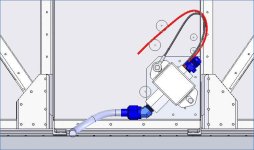Van's Air Force
You are using an out of date browser. It may not display this or other websites correctly.
You should upgrade or use an alternative browser.
You should upgrade or use an alternative browser.
Alternative to FACET 40180
- Thread starter Simon
- Start date
Tony Kirk
Well Known Member
Facet quit making the 40108 pump.
You can use the following parts to convert a 40135 NPT port pump into an AN6 style pump.
ES 40135 4.5-6 PSI 1/8" NPT Fuel Pump from Van's Store
AN816-6-2D 1/8" NPT to AN6 Straight Fitting from Van's Store
AN823-6-2D 1/8" NPT to AN6 45 degree Fitting currently not available from Van's - Google search to find one.
Here is how it goes together.

You can use the following parts to convert a 40135 NPT port pump into an AN6 style pump.
ES 40135 4.5-6 PSI 1/8" NPT Fuel Pump from Van's Store
AN816-6-2D 1/8" NPT to AN6 Straight Fitting from Van's Store
AN823-6-2D 1/8" NPT to AN6 45 degree Fitting currently not available from Van's - Google search to find one.
Here is how it goes together.

Tony, Brilliant, thank you.Facet quit making the 40108 pump.
You can use the following parts to convert a 40135 NPT port pump into an AN6 style pump.
ES 40135 4.5-6 PSI 1/8" NPT Fuel Pump from Van's Store
AN816-6-2D 1/8" NPT to AN6 Straight Fitting from Van's Store
AN823-6-2D 1/8" NPT to AN6 45 degree Fitting currently not available from Van's - Google search to find one.
Here is how it goes together.
View attachment 54853
scottjohnsontampa
I'm New Here
Exactly what I needed thankyou for respondingTony, Brilliant, thank you.
scottjohnsontampa
I'm New Here
Facet quit making the 40108 pump.
You can use the following parts to convert a 40135 NPT port pump into an AN6 style pump.
ES 40135 4.5-6 PSI 1/8" NPT Fuel Pump from Van's Store
AN816-6-2D 1/8" NPT to AN6 Straight Fitting from Van's Store
AN823-6-2D 1/8" NPT to AN6 45 degree Fitting currently not available from Van's - Google search to find one.
Here is how it goes together.
View attachment 54853
scottjohnsontampa
I'm New Here
Exactly what I needed thankyou for responding!
The 109 has a check valve..... Van's 135 does not.Facet has a pump, 40109, that has 3/8 NPT female threads if you want something larger than 1/8 NPT.
More resistance to flow.OK, I’m curious, how would that affect the use on a Lycoming?
The mechanical fuel pump would need to create more suction to more the same amount of fuel. This could (may) cause vapor lock to occur sooner.
Posted in another thread. And may apply here.....OK, I’m curious, how would that affect the use on a Lycoming?
It can also result in hard starts after a "hot soak" period, very rough
running, stalling after restart, and most dangerous, engine
cutoff on takeoff. What's the story? Gasoline can boil as
low as 83-86 F. When fuel passes a check valve in any
pump it can not back up. It's trapped, so it sits and absorbs
heat. Vapor forms. In a "hot soak" situation the vapor
pressure in the fuel line between the pump and the carb
can reach as high as 30 psi. This is more than enough to
overpower the fuel inlet valve in the carburetor, causing
the bowl to overflow raw fuel into the induction system.
The result is a variety of troubles. The first is very hard
starts. If the battery holds out and the engine starts to run,
there is usually tell-tale black smoke from the exhaust
until it clears the flooded, excess fuel. The engine may
start, run a short time and die. Reason? The engine used
the fuel available in the carburetor bowl and quit. Why?
Vapor pressure in the line builds high enough to keep the
pump from delivering new fuel.
Second, the engine may start but runs very rough for
considerable time before smoothing out. Large amounts
of vapor bubbles in the fuel line can disturb fuel flow into
the carb, as well as emit large amounts of vapor to the
engine through the internal carb vents.
Cut-out on takeoff is the most upsetting. Vapor can be
trapped in the system behind liquid fuel allowing the
engine to run normally for a while. But when the vapor
reaches the carb, the show is over. The fuel system up to
the manifold is designed to handle only liquid fuel. Vapor
is a problem. To get rid of it, just get rid of the vapor.




